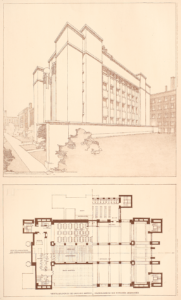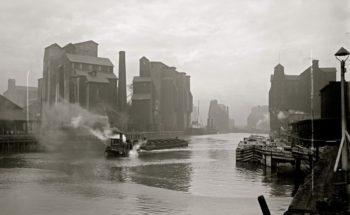Styles of Architecture in Buffalo
|
Reprint  Although the most obvious of skeptics would say no, particularly as the
Internationalist style was the natural ending of the anti-ornamental
sentiment that derived from Germanic countries in the late nineteenth
century. The progression of this style would have probably remained the
same, even if Buffalo had not existed, the Internationalist style would
have still progressed, even in America. Now, the Internationalist style
is unremarkably tied to a certain collective of architects and
theorists, and to these men, as women were so rarely architects until
the late twentieth century, Buffalo inspired and altered their ideas
and paths. These men were Walter Gropius, Ludwig Mies van der Rohe, and
Le Corbusier. The progression in twentieth century architecture is no
doubt due to these men, and in turn partially due to Buffalo.

Walter Gropius, Ludwig Mies van der Rohe, Le Corbusier

Wasmuth Portfolio-Larkin Administration Building (Profile & Plan)
There is an old story that in 1910, Frank Lloyd Wright’s Wasmuth
Portfolio, unable to be published in the United States, was instead
published in Germany. This portfolio, detailing the architect’s first
twenty professional years, was published and the trio of young
architects in the Berlin office of Peter Behrens, namely Ludwig Mies
van der Rohe, Le Corbusier, and Walter Gropius, took the day off to
analyze it. Being that Frank Lloyd Wright’s first big break into the
forefront of modern architecture was due to Buffalo, and especially his
Larkin Company commissions, multiple buildings in Buffalo were
included. These included the Larkin Administration Building, the Darwin
Martin House Complex, and the Walter Heath House. The works of Frank
Lloyd Wright, particularly the Larkin Administration Building, in
showing a new, more modern, design etiquette, in which ornament was in
building technique and functionality, and not as much in the Victorian
and current Edwardian appendages, were enlightening and transformative
for this great triumvirate of young architects.In seeing a new direction in architecture, as displayed in Buffalo, these three men came up with a new building method, almost completely on their own. After World War I, the destruction left in Europe found the older, historically stable building materials crumble and give way to bullets and mortar shells, so the styles of concrete, metal, and glass, unlike Wright’s brick, grew. The first of these three men, Walter Gropius, later the founder of the Bauhaus School and Harvard’s Graduate School of Design, released the Jahrbuch des Deutschen Werkbundes in 1913. This work was one of Gropius’s early architectural critiques, and in it he includes multiple pictures of American, particularly Midwestern and Great Lakes industrial buildings. Buffalo buildings included are the Washburn-Crosby (General Mills) and Dakota elevators. This first introduction of Buffalo’s industrial architecture invited other great European modernists, such as Eric Mendelsohn and Antonio Sant’Elia. The greatest connection to Buffalo’s grain elevators, though, are by Le Corbusier, as in the 1920s he made a Great Lakes cruise/pilgrimage to Buffalo. In his 1923 manifesto, Vers une Nouvelle Architecture, Le Corbusier includes an entire chapter, “Three Reminders to Architects,” interspersed with images of grain elevators from America and Canada. The most memorable parts of this chapter go as follow: The styles of Louis XIV, XV, XVI or Gothic, are to architecture what a feather is on a woman’s head; it is sometimes pretty, though not always, and never anything more. Architecture has graver ends; capable of the sublime, it impresses the most brutal instincts by its objectivity… Mass and Surface are the elements by which architecture manifests itself. Mass and surface are determined by the plan. The plan is the generator.This explanation of Le Corbusier’s intents in designing the built environment explain his later works, particularly in his experimentation in concrete, long before his peers. Only look at L’Unité d’Habitation in Marseille, Villa Savoye in Poissy, Ville Radieuse, Dom-Ino House, or the Maison Guiette in Antwerp, to see where these principles, derived from Buffalo’s grain elevators, are put into action. 
Grain Elevators in early 1900s
Due to his relationship with Philip Johnson and his introduction to America in the late 1930s, Ludwig Mies van der Rohe is known to have stopped in Buffalo, and likely stopped also to see the grain elevators. His opinions most probably were shaped by this event, as his early work dealt more with stone-based surfaces, and later more glass based. This evolution, which actually occurred about a decade later, is likely rooted in such encounter with pure functional design. To see how the grain elevators were able to leave a European architect in awe, the previously mentioned Eric Mendelsohn is quoted as late as 1986 as saying about Buffalo’s waterfront: Mountainous silos, incredibly space-conscious, but creating space a random confusion amidst the chaos of loading and unloading corn ships, of railways and bridges, crane monsters with live gestures, hordes of silo cells in concrete, stone and glazed brick. Then suddenly a silo with administrative buildings, closed horizontal fronts against the stupendous verticals of fifty to a hundred cylinders, and all this in the sharp evening light. I took photographs like mad. Everything else so far now seemed to have been shaped interim to my silo dreams.Buffalo had an impact on the major practitioners of Internationalism, Walter Gropius, Ludwig Mies van der Rohe, and Le Corbusier, therefore impacting the course of twentieth century architecture. Featured Image of the Bauhaus Dessau School Building (1919) designed by Walter Gropius. This building is one of the most famous early Internationalist Buildings. Citations Corbusier, Le. Towards a New Architecture. Mineola, NY: Dover., 1986. Print. Gropius, Walter. Jahrbuch Des Deutschen Werkbundes. Berlin: H. Reckendorf, 1913. Print. Tielman, Tim. Buffalo’s Unusual Claim to Architectural Fame. Buffalo Architecture and History. Wright, Frank Lloyd. Drawings and Plans of Frank Lloyd Wright. New York: Dover., 1983. Print. Pictures Courtesy of dmsasparchment, wikipedia, the Steedman Collection, Buffalo History Gazette |